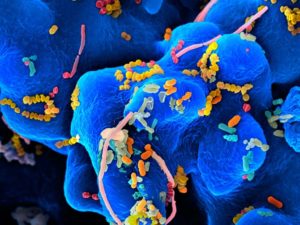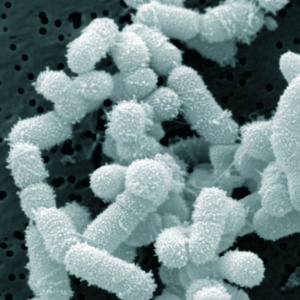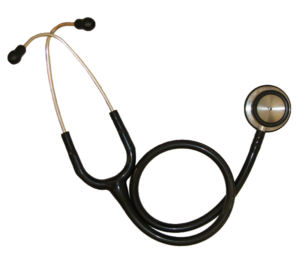 This study is noteworthy and relevant to humans (it was done on mice) because it may explain why so many people taking antibiotics get frequent viruses or seem more susceptible to infections. Once bacteria (both good and bad) are killed by antibiotics, then the community becomes unbalanced (dysbiosis), so that viruses may gain a foothold and a viral infection develops. In a healthy microbial community all sorts of microbes can be found, even ones we typically consider pathogenic, but the whole community keeps them in balance. One can say that "depletion of commensal microbiota also affects antiviral immunity".
This study is noteworthy and relevant to humans (it was done on mice) because it may explain why so many people taking antibiotics get frequent viruses or seem more susceptible to infections. Once bacteria (both good and bad) are killed by antibiotics, then the community becomes unbalanced (dysbiosis), so that viruses may gain a foothold and a viral infection develops. In a healthy microbial community all sorts of microbes can be found, even ones we typically consider pathogenic, but the whole community keeps them in balance. One can say that "depletion of commensal microbiota also affects antiviral immunity".
The study researchers said that the study findings were relevant to humans: that oral antibiotics could result in increased susceptibility to sexually transmitted infections, as well as other infectious viruses. Note: commensal microbes or commensalism is a the living together of two organisms (different species) in a relationship that is beneficial to one and has no effect on the other. Dysbiosis is microbial imbalance, the microbial community being "out of whack". From Science Daily:
Antibiotics may increase susceptibility to sexually transmitted infections
Commensal microbiota, populations of bacteria that inhabit the tissues of larger organisms, often have complex relationships with their hosts. Researchers have been aware for some time that commensal microbiota play a role in antiviral immunity by producing immune inductive signals that trigger inflammasome responses, among other things.
However, the role of dysbiosis on antiviral immunity hasn't been studied. Dysbiosis describes the loss of bacterial diversity within a microbiome, and the direct role that commensal microbiota play in antiviral immunity suggests that such loss would facilitate viral infections. Recently, a collaborative of Korean and Japanese scientists conducted a study into the effects of antibiotic-induced dysbiosis on antiviral immunity, and have published their results in the Proceedings of the National Academy of Sciences.
The researchers investigated the mechanisms of commensal microbial immunity on the genital mucosa by treating mice with antibiotics for four weeks and then exposing them to HSV-2. A control group received placebo. They report that the antibiotics caused dysbiosis within the vaginal microbiota, and resulted in a dramatic increase in innate immune response—specifically, they noted increases in an alarmin called IL-33, which blocked effector T cells from migrating into the vaginal tissues and secreting antiviral cytokines.
Antibiotic-treated mice succumbed to HSV-2 infection dramatically faster than control mice. They exhibited more severe pathology and all mice treated with antibiotics prior to viral exposure died within 11 days of infection. "Taking these data together, we find that depletion of commensal bacteria results in a severe defect in antiviral protection following mucosal HSV-2 infection," the researchers write.
By analyzing stool and vaginal washes from both groups of mice, they determined that antibiotic treatment induced an imbalance in the microbial composition of the vaginal mucosa. Further, they were able to determine that no single species of bacteria was responsible for the antiviral immunity effects of the commensal microbiome; rather, it was the imbalance of the microbiotic population that accounted for the effects.

The human mouth hosts a variety of microbes, some taking up residence on the mouth lining (blue) within days after birth. Credit: Martin Oeggerli (National Geographic)

 Once again, research shows that "BPA-free" plastic does not mean it is safer than BPA plastic. Both BPA and BPS (the usual replacement for BPA) leach estrogenic chemicals into the foods and beverages, which means negative health effects when ingested. Both BPA and BPS mimic the effects of estrogen, as well as the actions of thyroid hormone. Yes, this study was done on zebrafish, but think of them as "the canaries in the mine" - if it affects them, it could affect humans also, especially developing fetuses and young children.
Once again, research shows that "BPA-free" plastic does not mean it is safer than BPA plastic. Both BPA and BPS (the usual replacement for BPA) leach estrogenic chemicals into the foods and beverages, which means negative health effects when ingested. Both BPA and BPS mimic the effects of estrogen, as well as the actions of thyroid hormone. Yes, this study was done on zebrafish, but think of them as "the canaries in the mine" - if it affects them, it could affect humans also, especially developing fetuses and young children. I posted about this amazing research while it was still ongoing (
I posted about this amazing research while it was still ongoing ( It's now 3 years being free of chronic sinusitis and off all antibiotics! Three amazing years since I started using easy do-it-yourself sinusitis treatments containing the probiotic (beneficial bacteria) Lactobacillus sakei. My sinuses feel great! And yes, it still feels miraculous.
It's now 3 years being free of chronic sinusitis and off all antibiotics! Three amazing years since I started using easy do-it-yourself sinusitis treatments containing the probiotic (beneficial bacteria) Lactobacillus sakei. My sinuses feel great! And yes, it still feels miraculous. Why exercise alone won't get those pounds off - it's because the body adapts to higher exercise levels. We all suspected that, but it is depressing... From Medical Xpress:
Why exercise alone won't get those pounds off - it's because the body adapts to higher exercise levels. We all suspected that, but it is depressing... From Medical Xpress:
 This confirms what researchers such as
This confirms what researchers such as  Once again, two opposing views about beards have been in the news - that they harbor all sorts of nasty disease-causing bacteria vs they are hygienic. An earlier
Once again, two opposing views about beards have been in the news - that they harbor all sorts of nasty disease-causing bacteria vs they are hygienic. An earlier  A recent study using
A recent study using  Bad news about ticks: the blacklegged ticks (Ixodes scapularis and the western Ixodes pacificus) that spread Lyme disease, are now reported in almost half of the counties in the U. S. Researchers found blacklegged ticks in 1,420 out of 3,110 counties in the continental U.S., or about 46% of counties, and found western blacklegged ticks in 111 counties, or about 4%. Combined, this is a 45% increase from 1998 when ticks were reported in 1,058 counties.Of course the tick-dense northeast is where Lyme disease is most common. Although the blacklegged tick is found from Florida to Minnesota, 95% of confirmed Lyme disease cases come from just 14 states in the northeast and upper Midwest.
Bad news about ticks: the blacklegged ticks (Ixodes scapularis and the western Ixodes pacificus) that spread Lyme disease, are now reported in almost half of the counties in the U. S. Researchers found blacklegged ticks in 1,420 out of 3,110 counties in the continental U.S., or about 46% of counties, and found western blacklegged ticks in 111 counties, or about 4%. Combined, this is a 45% increase from 1998 when ticks were reported in 1,058 counties.Of course the tick-dense northeast is where Lyme disease is most common. Although the blacklegged tick is found from Florida to Minnesota, 95% of confirmed Lyme disease cases come from just 14 states in the northeast and upper Midwest.  This study found that greater intake of dietary nitrate and green leafy vegetables was associated with a 20 percent to 30 percent lower risk of primary open-angle glaucoma (POAG), which is the most common form of glaucoma. Glaucoma can lead to vision loss and even blindness (if left untreated).There is evidence that nitric oxide has a role in primary open-angle glaucoma, and that dietary intake of nitrates is beneficial. Green leafy vegetables (iceberg lettuce, romaine lettuce, mustard, or chard, cooked spinach, and raw spinach) were found to be most beneficial, as well as kale and collard greens. Those who ate the most green leafy vegetables ate about 1.5 servings per day, versus .3 servings daily in the lowest intake group.
This study found that greater intake of dietary nitrate and green leafy vegetables was associated with a 20 percent to 30 percent lower risk of primary open-angle glaucoma (POAG), which is the most common form of glaucoma. Glaucoma can lead to vision loss and even blindness (if left untreated).There is evidence that nitric oxide has a role in primary open-angle glaucoma, and that dietary intake of nitrates is beneficial. Green leafy vegetables (iceberg lettuce, romaine lettuce, mustard, or chard, cooked spinach, and raw spinach) were found to be most beneficial, as well as kale and collard greens. Those who ate the most green leafy vegetables ate about 1.5 servings per day, versus .3 servings daily in the lowest intake group.